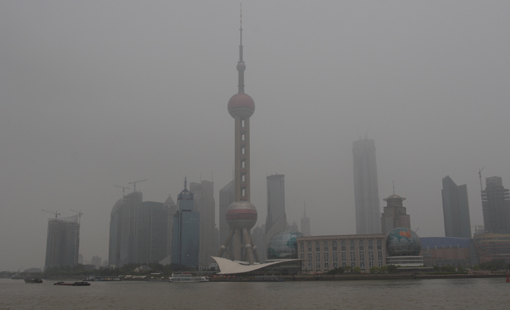
By Lina Fedirko
Climate Risks
Shanghai’s water infrastructure provides 56.1% of the total water supply to its industry sector, which includes power plants and coal-fired factories, 14.3% to agriculture, and 10.1% to the 23 million residents of its greater municipality (United Nations Environmental Programme, 2010). According to United Nations, Shanghai is one of six cities in the world facing severe water shortages, (Xinhua, 2010), which poses a threat to the city’s residents, agricultural output, energy production, and economic productivity.
A climate risk assessment (Mehrotra et al., 2009) shows that primary risks exacerbated by climate change are salt-water intrusions and eutrophication, which affect the quantity and quality of water supply. The projected increase in precipitation and sea level rise, in combination with Shanghai’s location (Yangtze mega-delta and Huagpu River), naturally low elevation, flat topography and ground subsidence, is expected to exacerbate flooding, causing salt-water intrusion to the water supply (United Nations Human Settlements Programme, 2010, p. 176). Salt-water intrusions into the water supply from the Yangtze mega-delta is attributed to rising sea level and will affect 20% of Shanghai’s total water supply (Cruz et al., 2007). Projected temperature increase is expected to cause a rise in surface water temperature, exacerbating incidents of eutrophication, reducing adequate water supply (UNEP, 2010, p. 99).
Adaptation and Mitigation
Shanghai’s adaptation efforts include: construction of a new water source to secure drinking water supply, development of an informal water supply system to reduce water stress, and increased management of wastewater treatment to improve water quality.
In preparation for the World Expo in 2010, a third water source was constructed in addition to Huangpu River and the Chanhang Reservoir on Yangtze Estuary, providing 80% and 20% of the total water supply respectively (UNEP, 2010, p. 87). The Qingcaosha Reservoir currently accounts for approximately 5% of the total water supply (Anonymous, 2010) and is expected to supply 10 million people once it reaches its full operating capacity (UNEP, 2010, p. 88). This addition is expected to improve the quality of Shanghai’s drinking water, reduce water stress during incidents of eutrophication and seawater intrusion to Chanhang Reservoir. In an effort to improve water quality, Shanghai is also planning to source 70% of its tap water from the Yangtze River (Anonymous, 2010).
In the past year, the Shanghai water authority has focused on developing an informal water supply network by constructing wells to serve as a source supplement in case of future disasters (Anonymous, 2011). This initiative serves as a co-benefit to mitigate water shortages due to climate change. The city has also increased its wastewater treatment by 75.5% through construction of new treatment facilities and man-made wetlands (UNEP, 2010). This effort is expected to decrease incidents of eutrophication and related economic resulting from clean-up efforts.
Recommendations
To reduce industry’s heavy reliance on water, Shanghai municipal government should mandate in-house recycling and re-use of water for all manufacturing facilities. The government should provide a timeline for upgrading and consider monetary incentives, such as grants or tax credits, to aid the process. This approach is expected to increase water availability for residential usage and for agriculture industry by reducing competition with developed industry. In addition, this will reduce the industry sector’s reliance on an unstable water supply and increase its resiliency to water shortages in case of an emergency.
Furthermore, Shanghai Municipality should conduct a thorough assessment of flood-prone areas and mandate all industrial entities to report on economic implications in the case of several projected flood scenarios as well as responsive adaptation plans. This is expected to alleviate economic damages and increase adaptive response in case of a flood.
References
Anonymous (2010, November 25). New reservoir boosts water quality in Shanghai. Xinhua News Agency ‘ CEIS. Retrieved from ProQuest Newsstand. Retrieved on November 25, 2011 http://search.proquest.com.libproxy.newschool.edu/docview/814576314?accountid=12261.
Anonymous. (2011, March 22). Shanghai looks for alternative water sources for use in future emergencies. Xinhua News Agency ‘ CEIS. Retrieved from ProQuest Newsstand. Retrieved on November 25, 2011 http://search.proquest.com.libproxy.newschool.edu/docview/858122026?accountid=12261
Cruz, R.V., Harasawa, H., Lal, M., Wu, S., Anokhin, Y., Punsalmaa, B., Honda, Y., Jafari, M., Li, C., & Huu Ninh, N. (2007). Asia. Climate Change 2007: Impacts, Adaptation and Vulnerability; Contribution of Working Group II to the Fourth Assessment Report of the Intergovernmental Panel on Climate Change. University Press, Cambridge, UK. Retrieved from http://www.ipcc.ch/pdf/assessment-report/ar4/wg2/ar4-wg2-chapter10.pdf.
Mehrotra, S., C.E. Natenzon, A. Omojola, R. Folorunsho, J. Gilbride & C. Rosenzweig. (2009). Framework for city climate risk assessment. Washington, DC: World Bank.
United Nations Environmental Programme. (2010). UNEP Environmental Assessment: EXPO 2010, Shanghai, China (Job Number: DCP/1209/NA). Nairobi, Kenya. Retrieved from http://www.unep.org/pdf/SHANGHAI_REPORT_FullReport.pdf
United Nations Human Settlements Programme (UN HABITAT). (2010). The state of Asian cities 2010/2011 (HS Number: HS/162/10 E; ISBN: Volume 978-92-1-132274-3). Fukuoka, Japan. Retrieved on November 25, 2010 http://www.unhabitat.org/pmss/listItemDetails.aspx?publicationID=3078
This article is a product of Professor Shagun Mehrotra’s Climate Change and Cities class. Views expressed are entirely those of the individual author.